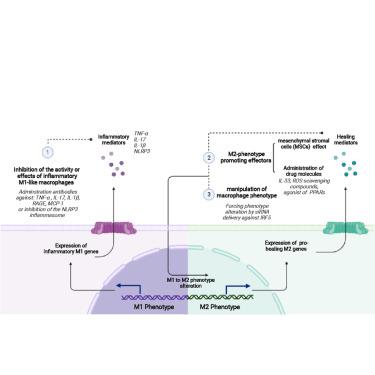Molecular Therapy ( IF 12.1 ) Pub Date : 2022-08-02 , DOI: 10.1016/j.ymthe.2022.07.016 Maryam Sharifiaghdam 1 , Elnaz Shaabani 1 , Reza Faridi-Majidi 2 , Stefaan C De Smedt 3 , Kevin Braeckmans 4 , Juan C Fraire 3

|
It is well established that macrophages are key regulators of wound healing, displaying impressive plasticity and an evolving phenotype, from an aggressive pro-inflammatory or “M1” phenotype to a pro-healing or “M2” phenotype, depending on the wound healing stage, to ensure proper healing. Because dysregulated macrophage responses have been linked to impaired healing of diabetic wounds, macrophages are being considered as a therapeutic target for improved wound healing. In this review, we first discuss the role of macrophages in a normal skin wound healing process and discuss the aberrations that occur in macrophages under diabetic conditions. Next we provide an overview of recent macrophage-based therapeutic approaches, including delivery of ex-vivo-activated macrophages and delivery of pharmacological strategies aimed at eliminating or re-educating local skin macrophages. In particular, we focus on strategies to silence key regulator genes to repolarize wound macrophages to the M2 phenotype, and we provide a discussion of their potential future clinical translation.
中文翻译:

巨噬细胞作为促进糖尿病伤口愈合的治疗靶点
众所周知,巨噬细胞是伤口愈合的关键调节因子,表现出令人印象深刻的可塑性和不断变化的表型,从侵袭性促炎或“M1”表型到促愈合或“M2”表型,具体取决于伤口愈合情况阶段,以确保适当的愈合。由于巨噬细胞反应失调与糖尿病伤口愈合受损有关,因此巨噬细胞被认为是改善伤口愈合的治疗靶点。在这篇综述中,我们首先讨论巨噬细胞在正常皮肤伤口愈合过程中的作用,并讨论糖尿病条件下巨噬细胞发生的畸变。接下来,我们概述了最近基于巨噬细胞的治疗方法,包括递送离体激活的巨噬细胞和递送旨在消除或重新教育局部皮肤巨噬细胞的药理学策略。我们特别关注沉默关键调节基因以使伤口巨噬细胞重新极化至 M2 表型的策略,并讨论了它们未来潜在的临床转化。










































 京公网安备 11010802027423号
京公网安备 11010802027423号